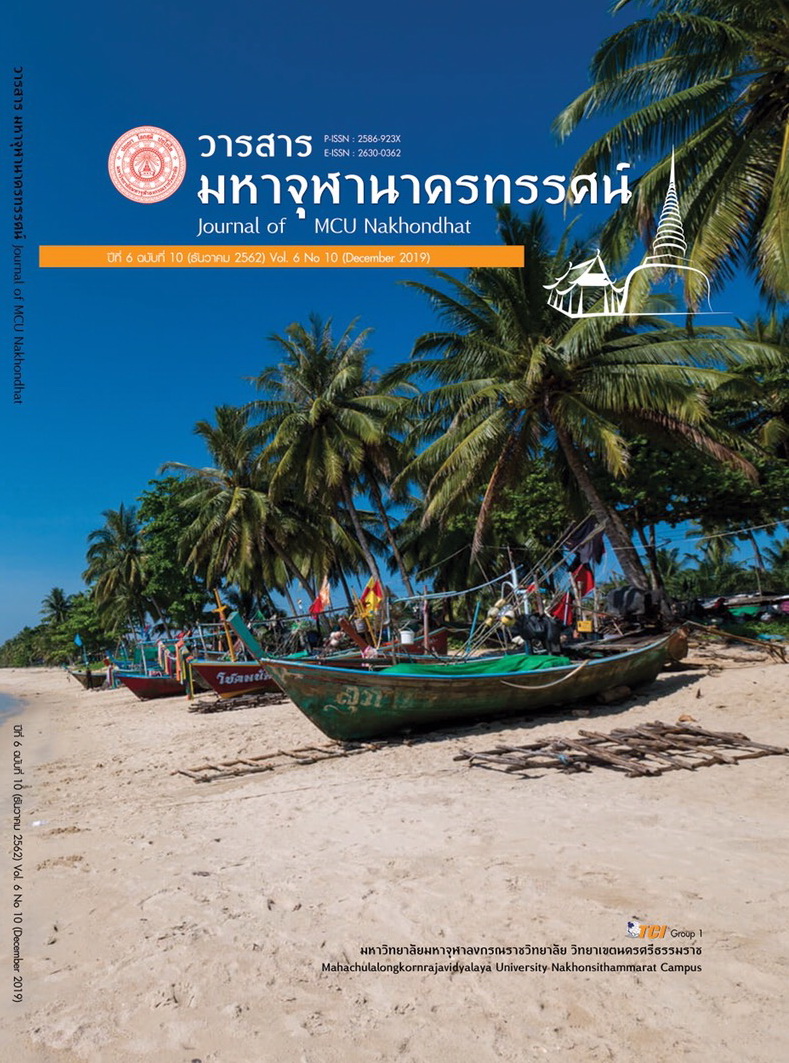THE PROPOSED IMPLEMENTATION FOR THE IMPROVEMENT OF THE SECOND CITIZEN (HOMELESS PEOPLE LIVE IN PUBLIC PLACES) APPROACHED BY THE CIVIL SOCIETY NETWORK OF SURATTHANI
Main Article Content
Abstract
The purposes of The Proposed Implementation for the Improvement of the Second Citizen (Homeless people live in public places) Approached by the Civil Society Network of Suratthani were to 1) study the society of the Second Citizen living together (Homeless people live in public places) in Surat Thani province 2) study the behavior causing to be the Second Citizen (Homeless people live in public places) in Surat Thani Province and 3) present the results to the civil society network of Surat Thani Province. This is a qualitative research. The researcher went to a field to collect data by interviewing and observing together with key informants. There were two groups including social workers, psychologists, social developers, five academicians and twelve homeless people. A total of persons was 17. The research results were presented by descriptive analysis method.
The results of the research showed that:
The development processes of the Second Citizen (Homeless people) of the Civil Society Network of Suratthani consisted of the following main points. 1) The study of the society of the Second Citizen living together (Homeless people live in public places) in Surat Thani province was found that there were 4 secondary issues as follows: (1) The Second Citizen (Homeless people)’s life styles was basic factors consisting of (1.1) the demand that he knew what he wanted but they could not do it by themselves because of lack of knowledge and experiences (1.2) they did not feel the requirement they wanted because of familiarity (1.3) they did not know the requirement that still remained. (2) The behavior of the Second Citizen (Homeless people) was found that most of them were mentally ill. (3) Knowing the information of The Second Citizen (Homeless people) was found that they were unable to access knowledge about obtaining their rights. (4) The interaction of The Second Citizen (Homeless people) with those around them reflected the complex state of the current Thai society situations. 2) The behavior causing to be the Second Citizen (Homeless people) was found that there were 2 secondary issues as follows: (1) The background of The Second Citizen (Homeless people) and those around them were homeless. They lived in public areas. That cound be divided into 2 large groups; Group 1 was missing persons. Group 2 was people with mental or psychiatric illness. (2) Behavior showed to the society was found that people in the society ignored The Second Citizen (Homeless people) because they were unrelated and not important. This situation created conditions for violence against The Second Citizen (Homeless people) 3) Presenting the development process of The Second Citizen (Homeless people) of civil society networks in Surat Thani province was "Team One Home, Social Support Center". The institutions will continue to work together in the network linking the development process for The Second Citizen (Homeless people) the in the future. Consists of 9 aspects as follows: (1) Social welfare provision (2) Promotion of capacity building Physical and mental (3) Medical treatment (4) Educational and career promotion 5) Promoting and creating opportunities in society (6) Quality of life development (7) Support for the dependent (8) Support for the homeless (9) preventing unfair discrimination against those who are dependent.
Article Details
References
จักรพันธุ์ โอฬาริกชาติ. (2561). มาตรการทางกฎหมายในการคุ้มครองคนไร้ที่พึ่งที่เป็นผู้ป่วยทางจิตเร่ร่อน. วารสารมหาวิทยาลัยพายัพ, 28(1), 45-55.
ปริตรตา เฉลิมเผ่า กออนันตกูล. (2545). ชีวิตชายขอบ ตัวตนกับความหมาย เอกสารวิชาการลำดับที่ 24. กรุงเทพมหานคร: ศูนย์มนุษวิทยาสิรินทร.
พงศธร สรรคพงษ์. (2560). นไร้บ้านที่ทอดทิ้งครอบครัว ศึกษาเฉพาะกรณี คนไร้บ้านในพื้นที่เขตเทศบาลนครพิษณุโลก. วารสารสังคมศาสตร์, 29(2),39-70.
พุทธทาสภิกขุ. (2560). ภาพลิ้นงูอยู่ในปากงู. เรียกใช้เมื่อ 15 กันยายน 2560 จาก http://oknation.nationtv.tv/blog/Aug-saraporn/2012/01/13/entry-
สาณุรักษ์ ฟ่องวาริน. (2559). กระบวนการกลายเป็นคนชายขอบ: ศึกษาเฉพาะกรณีคนขอทานในเขตราชเทวี กรุงเทพมหานคร. เรียกใช้เมื่อ 2 สิงหาคม 2559 จาก www. sccthailand.org
อานันท์ กาญจนพันธุ์. (2549). การต่อสู้เพื่อความเป็นคนของคนชายขอบในสังคมไทยมองลอดความรู้ รวมบทความเนื่องในวาระครบรอบ 60 ปี. กรุงเทพมหานคร: สำนักพิมพ์มติชน.

